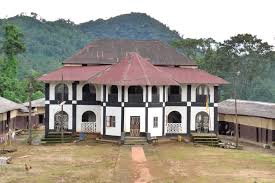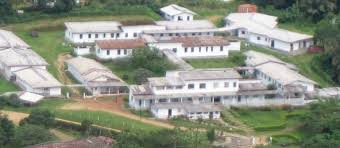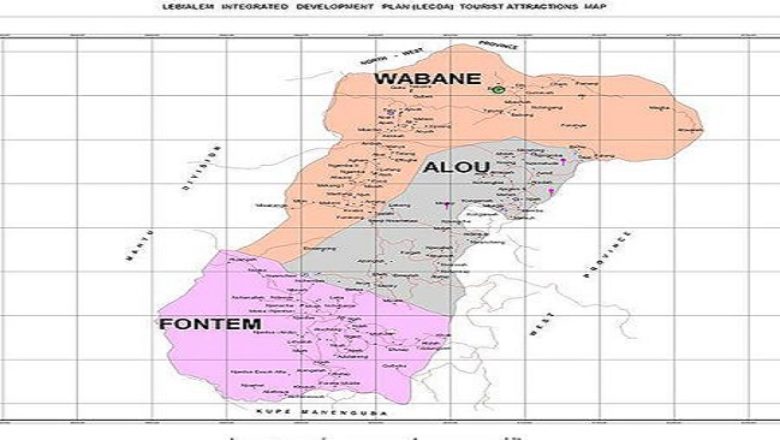Fontem
Fontem Sub Division is one of the three sub divisions in the Lebialem Division of the South West Region of Cameroon.
It is bounded to the East by Fongo-Tongo area
found in the West region, to the North West by Wabane Municipality, to the
North by Alou council area, to the South West by Tinto municipality found in
the Manyu Division and to the South by Nguti which is found in the Kupe
Muanenguba Division. It is about 106 km² large.
Population
The area has an estimated population of 27875 with 49%
female population and 51% males. The population density is estimated at 263
persons/km² on a total land surface of 106km².
  |
History
The Bangwas, as popularly known by many, have inhabited this area for less than two hundred years. In brief, history tells a story of a hunter who came from the Bayang forest with his family and nine classic servants where he met the Beketshes, a group of hunting and gathering people who lived a naked and nomadic existence in the wooded mountains without advantages of agriculture. The forest hunter with his gun and through guile, immediately deprived them of their proprietary right to the land. A myth tells of how he hoarded leopard skin, ivory tusk and lengths of stenciled blue and white cloths which immediately and indisputably ranked him as a chief. The Beketshe are described in many stories as brainless, fickle and incredibly gullible and a source of amusement to the Bangwa people.
Ethnic Groups
The Nweh is the main ethnic group in this area distributed in the three Fondoms of Essoh-Attah, Lebang and Njoagwi. Most of the people are intermarried with their neighbours such as the Mbos, Bayangs, Bamilekes and the inhabitants of Upper and Lower lewoh. Non-natives who are businessmen and civil servants and many international volunteers like the Italian movement FOCOLARE base in Mveh are also found in this area.
Climate and Relief
The Cameroon-montane type of climate is typical of this area. It is made of two main seasons. The short dry season approximately experienced for four months usually shorter than the wet season which is longer and last for 7 months. The short dry season is experienced from the month of December to the month of April with occasional rainfall during the period. While the long wet season starts from the month of April to November and sometimes to December with very high amount of rainfall in the months of September and October. The maximum rainfall has been slightly above 900 mm, with highest temperatures than any other part of the division.
The topography of the area is very uneven and difficult to inhabit. The area has an awe-inspiring mountainous scenery with steep perilous roads and paths crossed by rushing streams. The area is seen as an area which was hastily made, though magnificent as it is often described as an area of hills and valleys.
Vegetation and Fauna
The most common species of trees found in this area are iroko, palm trees, Indian bamboo, ebony, and silk cotton tree with a series of climbers such as wild rubber. The area is also remarkable in natural ecological systems with None Timber Forest product (NTFP) sustainably managed with agro-ecological system characterised with crops like palm trees, cocoa, coffee, eru, cashew, monkey kola, bitter kola and kola nuts.
This area has abundant forest flora, ecosystems and biological intervention which are located in the forest blocks of Mbin-belluah, Mbin-mak, Mbin-andu and Mbin-essoh. With an increase in human activities such as hunting, agriculture and deforestation is mounting a lot of pressure on the flora resources, consequently leading to degradation of the forest blocks.
Fontem is also rich in fauna biodiversity as some of the world’s rarest species of primates are found in the Mbin-belluah, Mbin-mak, Mbin-andu and Mbin-essoh forst blocks such as chimpanzees, baboons, monkeys and gorillas. These species are seen as a treasure to tourist if well protected. Others in leopards, elephants, deer, antelopes, birds, porcupines and grass-cutter.
Hydrology
Many rivers and streams are found in this council area that run down the hilly topography. Most streams in this area are drying off due to climatic change and human activities like deforestation and others. Most rivers found in this area include rivers like Ntsembue, Bejie, Mbi, Geleh, Betsue, Mbra, Bechou, Mbelep Agonayi, Betenten, Bejeuh, Efrue and river Ntse-cha which was mispronounced by the Germans as cha-cha and it is from the river that the name Foreke cha- cha a small village in the area was derived. The streams in this area are characterized by fluctuation in their volumes which reduces during the dry season and increases during the rainy season, have both tropical and equatorial regimes, and have rugged beds and flow in a series of rapid and are also in their youth ages.
Soil
The areas of Ndungweh and Quibekwu are mostly made of shallow ferruginous materials derived from ancient basalt. Ferrallitic soils are found in the northern part of the council area derived from granite and some patches of laterite found down south of the area. The soils contain a high rate of humus formation accompanying the high rate of leaf fall and decay. Due to the high amount of rainfall in the area, the rate of erosion is very high and the soils are heavily leached especially in Upper and Middle Essoh-Attah and towards Njoagwi.
Socio-Economic Activities
The inhabitants of Fontem Sub Division practice mainly farming which is mostly subsistence, hunting and a small scale of livestock production. These activities have been their main source of income even though yields are low due to infertile soils, diseases and the ageing population. Food crops cultivated include, coco-yam, cassava, bananas, beans, plantains and vegetables with cash crops like cocoa and Robusta coffee. Livestock production is also carried out where cattle, pigs, cattle, sheep, fowls and goats are carried out.
Educationally, this area is home to several primary and secondary schools like Our Lady Seat of Wisdom College (SWISCOL), GBHS Fontem and a host of others.
Fontem Sub Division also have many hospitals especially the Mary Health of Africa which is controlled by the FOCOLARE MOVEMENT and specializes in the treatment of infectious tropical conditions such as Sleeping Sickness, HIV, Malaria, Typhoid and TB.
Religion
Christianity is the main religion practiced in Fontem, with majority of the Christians being the Roman Catholic Mission and other religious groups like Presbyterian, Full Gospel, Apostolic and Baptist Mission.
Tell us More About Fontem
Have A Great Story About This Place?
Do you have a great story or pictures about this place? Share it!
Hope you love this page on Fontem. Click here to return to our Home page.
